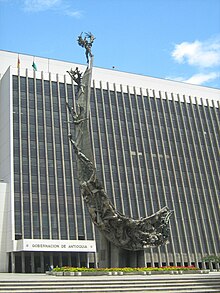Monumento a la Raza (Medellín)
 The monument in 2008 | |
 | |
| 06°14′40″N 75°34′24″W / 6.24444°N 75.57333°W | |
| Location | Medellín, Colombia |
|---|---|
| Designer | Rodrigo Arenas Betancourt |
| Material | Concrete and bronze |
| Height | 38 meters (125 ft) |
| Weight | 900 metric tons (890 long tons; 990 short tons) |
| Opening date | 31 May 1988 |
| Dedicated to | La Raza Antioqueña |
The Monumento a la Raza, also known as Monumento a la Raza Antioqueña,[1][2] is an outdoor sculpture and monument in the city of Medellín, Antioquia, Colombia. It is constructed of concrete and bronze, and it was created by Colombian sculptor Rodrigo Arenas Betancourt (1919–1995). It was inaugurated in the central square of the La Alpujarra Administrative Center on 31 May 1988.
The monument is made of a curved concrete structure covered in several bronze sculptures that represent Antioquian culture. In 2016, an urn holding a portion of Arenas' remains was set up next to the artwork.
History and construction
[edit]The Medellin government approved the erection of a monument honoring La Raza on 4 September 1975.[3]
Colombian sculptor Rodrigo Arenas Betancourt aimed to capture the culture and people of Antioquia in his artwork.[1] Plaster and concrete were used to construct the monument's base.[1]
It was inaugurated on 31 May 1988,[4] being blessed by cardinal bishop Alfonso López Trujillo.[5] During the inauguration, Arenas said:
"We have to inaugurate this monument to Antioquia in unfortunate moments of immense, intense and extensive pain; moments in which the motherland is being dismembered, is being inexorably mutilated, submerged in destruction and cannibalism."[A]
During the 203-year anniversary commemoration of the Independence of Antioquia in August 2016, Arenas was honored and part of his remains were transferred to an urn next to the monument.[4]
Status
[edit]The monument is exposed to multiple contaminants,[6] including pollution, moss, and pigeons and their feces. The damage is visible to the naked eye. In August 2016, then-governor of Antioquia Luis Pérez Gutiérrez announced a restoration, but as of April 2018 it had not been conducted.[4]
Description and interpretation
[edit]The Monumento a la Raza rises to 38 meters (125 ft) in height,[4] and weights 900 metric tons (890 long tons; 990 short tons).[1] The Museo Universitario de Artes Digitales described the monument as a brown curved sculpture that points to the sky. According to the museum, the monument symbolizes the culture of Antioquia, including its agriculture, religion, and solidarity.[6] The museum interpreted the work as a method to expose Arenas' early life in the Antioquia's farmlands.[6] Andrés Carvajal López from the EAFIT University said it portraits the story of the people that came out of the mud attempting to reach the top, starting from the bottom and trying to reach divinity in the zenith.[1] María Elena Quintero, poet and widow of Arenas, said:
"He interpreted and made a concrete-and-bronze epic, where he told the history of Antioquia, like the jobs, the mythology, among others. This work is a horseshoe that is on a pedestal and inside the development, colonization and Paisa history broadens".[B]
Reception
[edit]Sarah Woods described the Monumento a la Raza as a "powerful [and] robust" work that depicts "the forces of good and evil".[7]
Gallery
[edit]-
Detail of the lower part of the monument in 2018. The ambient damage is visible in some sculptures.
-
Detail of the top of the monument.
-
The urn installed on 11 August 2016.
Notes
[edit]- A ^ Original text in Spanish: "Nos toca inaugurar este monumento a Antioquia en momentos aciagos de inmenso, intenso y extenso dolor; momentos en que la patria se va desmembrando, se va mutilando inexorablemente, sumergida en la destrucción y el canibalismo".[4][5]
- B ^ Original text in Spanish: "[...] Él interpretó e hizo una epopeya de concreto y bronce, donde contó la historia de Antioquia, como los oficios, la mitología, entre otros. Esta obra es una herradura que está en un pedestal y dentro de esa forma se desarrolla el desarrollo, colonización e historia paisa".[2]
References
[edit]- ^ a b c d e Carvajal López, Andrés. "Elogio a la antioqueñidad" [Praise to the Antioquenity]. Nexos (in Spanish). EAFIT University. Archived from the original on 22 January 2021. Retrieved 19 January 2021.
- ^ a b "Antioquia celebra 203 años de Independencia con un homenaje al escultor Rodrigo Arenas" [Antioquia celebrates 203 years of Independence with a tribute to the sculptor Rodrigo Arenas] (in Spanish). RCN Radio. 11 August 2016. Archived from the original on 22 January 2021. Retrieved 21 January 2021.
- ^ Restrepo Uribe, Jorge; Posada de Greiff, Luz (1981). Medellín, su origen, progreso y desarrollo (in Spanish). Medellín: Serigráficas. p. 615. OCLC 656868399.
- ^ a b c d e Nieto Álvarez, Javier (15 April 2018). "Monumento a La Raza espera con ansias un día de limpieza" [Monumento a La Raza waits anxiously a cleaning day]. El Tiempo (in Spanish). Medellín. Archived from the original on 22 January 2021. Retrieved 17 January 2021.
- ^ a b El Colombiano (31 May 2013). "Un día como hoy. El Colombiano, Mayo 31" [On this day. El Colombiano, May 31] (in Spanish). Casillero de Letras. Archived from the original on 22 January 2021. Retrieved 21 January 2021.
- ^ a b c "Monumento A La Raza" (in Spanish). Museo Universitario de Artes Digitales. Archived from the original on 22 January 2021. Retrieved 16 January 2021.
- ^ Woods, Sarah; McColl, Richard (2015). Colombia. Guilford, Connecticut: Bradt Travel Guides. p. 340. ISBN 978-1-84162-921-6.
External links
[edit] Media related to Monumento a la Raza at Wikimedia Commons
Media related to Monumento a la Raza at Wikimedia Commons



